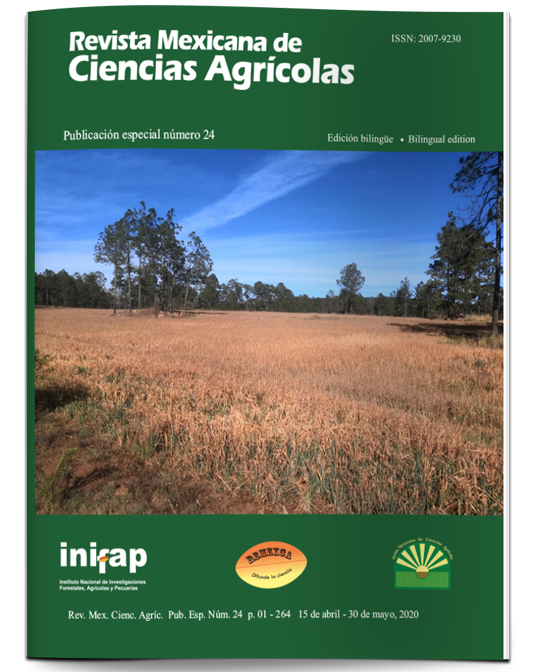Yield of white clover associated with ovillo grass at different grazing frequencies
DOI:
https://doi.org/10.29312/remexca.v0i24.2353Keywords:
grass, grazing frequency, legumeAbstract
The objective of the study was to evaluate the behavior of white clover associated with ovillo grass at four grazing frequencies. The treatments were fixed frequencies of 28 d in spring-summer and 35 d in autumn-winter and when the grassland intercepted 95 and 100% of intercepted radiation. Treatments were assigned to experimental units according to a randomized block design in divided plots with three replications. The variables evaluated were dry matter yield (DMY), botanical and morphological composition (BMC, %), growth rate (GR), intercepted radiation (IR, %) and height. The frequency of grazing during the winter modified the accumulation of dry matter (3885 kg DM ha-1; p< 0.05). The GR was higher in the grazing frequency at 28 d in spring (70 kg DM ha-1 d-1; p< 0.05). The highest height was reached at 28 d in the summer (26 cm; p< 0.05). Grazing frequency did not affect Grassland yield, except in winter when the best yield was obtained by grazing at 95% IR. The IR and the height of the plant are indicative of the dry matter yield and optimal harvest time
Downloads
Downloads
Published
How to Cite
Issue
Section
License
The authors who publish in Revista Mexicana de Ciencias Agrícolas accept the following conditions:
In accordance with copyright laws, Revista Mexicana de Ciencias Agrícolas recognizes and respects the authors’ moral right and ownership of property rights which will be transferred to the journal for dissemination in open access. Invariably, all the authors have to sign a letter of transfer of property rights and of originality of the article to Instituto Nacional de Investigaciones Forestales, Agrícolas y Pecuarias (INIFAP) [National Institute of Forestry, Agricultural and Livestock Research]. The author(s) must pay a fee for the reception of articles before proceeding to editorial review.
All the texts published by Revista Mexicana de Ciencias Agrícolas —with no exception— are distributed under a Creative Commons License Attribution-NonCommercial 4.0 International (CC BY-NC 4.0), which allows third parties to use the publication as long as the work’s authorship and its first publication in this journal are mentioned.
The author(s) can enter into independent and additional contractual agreements for the nonexclusive distribution of the version of the article published in Revista Mexicana de Ciencias Agrícolas (for example include it into an institutional repository or publish it in a book) as long as it is clearly and explicitly indicated that the work was published for the first time in Revista Mexicana de Ciencias Agrícolas.
For all the above, the authors shall send the Letter-transfer of Property Rights for the first publication duly filled in and signed by the author(s). This form must be sent as a PDF file to: revista_atm@yahoo.com.mx; cienciasagricola@inifap.gob.mx; remexca2017@gmail.
This work is licensed under a Creative Commons Attribution-Noncommercial 4.0 International license.



